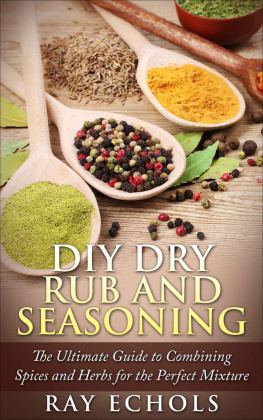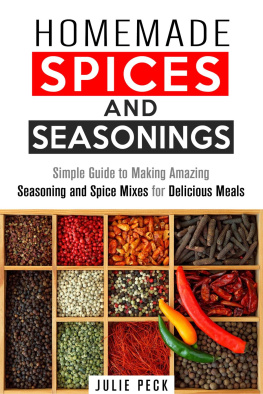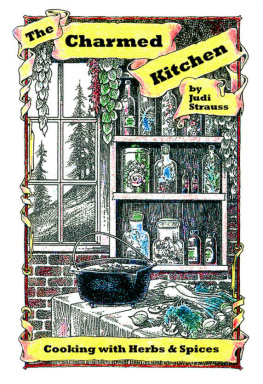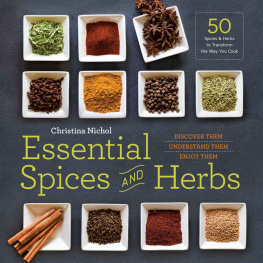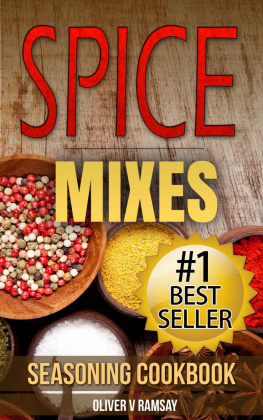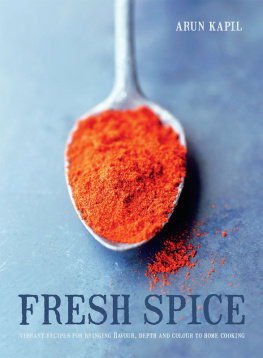DIY Dry Rub and Seasoning: The Ultimate Guide to Combining Spices and Herbs for the Perfect Mixture 
All rights Reserved. No part of this publication or the information in it may be quoted from or reproduced in any form by means such as printing, scanning, photocopying or otherwise without prior written permission of the copyright holder. Disclaimer and Terms of Use: Effort has been made to ensure that the information in this book is accurate and complete, however, the author and the publisher do not warrant the accuracy of the information, text and graphics contained within the book due to the rapidly changing nature of science, research, known and unknown facts and internet. The Author and the publisher do not hold any responsibility for errors, omissions or contrary interpretation of the subject matter herein. This book is presented solely for motivational and informational purposes only.
Table of Contents
An Introduction and History of Spices and Seasonings
We normally think of spices as a generic term for all the powders that we keep in little racks and use to season foods.
However, there is a distinction between all the little things that add flavor to our meals. An herb is specifically the dried leaf of a plant that can be used for seasoning or medicinal purposes. Examples of herbs include bay leaves, basil, and cilantro. A spice is any other part of the plant, such as seeds, roots, or bark used to flavor food. Ginger, garlic, and cinnamon are all spices. Salt, which is an essential staple in any kitchen, is neither an herb nor a spice it is a mineral.
This means that it doesn't go bad, and it is even used to preserve meats and other foods. Most spices grow in the tropical regions of the world, such as India, Africa, and Central America, while herbs can be grown in more temperate climates. The very first spices were thought to have been cinnamon and pepper, grown in South Asia and the Middle East around 2000 BCE. In ancient Asia and the Middle East, many spices and herbs were thought to have magical or healing purposes, rather than just taste advantages. Egyptians used many spices in embalming, which stimulated the global spice trade. Shipping trade routes formed between Asia, the Middle East, and Europe with the port city of Alexandria, Egypt as the epicenter of trade.
Whoever controlled the spice trade had power over the rest of the world -- first Arabs and Egyptians in early civilizations, then Romans, then Europeans. Once America was discovered, spices were a part of the triangle trade in the Caribbean with chili peppers, vanilla, allspice, and cocoa. Spices can also be used for medicinal or cosmetic purposes. Because spices and herbs are often brightly colored, they are sometimes used to color cosmetics. Flowers are often used as fragrances as well. Spices like ginger and garlic have antibiotic or antifungal properties that are more than just folk legend.
Capsasin, which is the substance that makes chilli peppers spicy, can be used in pain relief creams. So why should you make your own spices and seasonings? Storebought spices are often diluted to save money and maintain lower prices. Fresher seasonings result in fresher and stronger flavor. Plus you will know exactly what is going into the seasonings and can avoid filler and preservatives.
Tools Required to Get Started
Garlic press : This is an invaluable tool that saves a lot of time in the kitchen. Get a good quality press that is made of metal and it will last a lifetime.
Simply pop an unpeeled garlic clove in the chamber and squeeze it, and you've got instant diced garlic. Grinder : Grinders aren't just for pepper anymore. Often marketed as coffee grinders, you can purchase a cheap, hand-crank grinder or a fancy electric model it just depends on your budget and how much work you want to put into it. Keep in mind that a good quality electric grinder will last you longer than a hand-crank version because you will put less stress on it (and yourself). Any spices that come as whole corns, like cloves or peppercorns, you'll want to put through the grinder. Herb garden : Growing your own herbs will ensure that you get the freshest ingredients.
Miniature herb gardens are usually grown in one small pot and can be kept on a windowsill or patio in partial sun. They usually include a mixture of cilantro, basil, rosemary, parsley, and other green herbs. You can assemble your own herb garden in separate pots if you have more space. Herb gardens should be kept off of the ground to keep insects and snails from munching on them. Mason Jars : Glass is the most safe and renewable container material. You can use and reuse them to keep your leftover spices fresh.
Mortar and Pestle : This may seem like something out of an old time movie, but a mortar and pestle is the best way to crush fresh, leafy herbs an release their flavor. It can also be used to crush peppercorns, garlic, nuts (for crusting meat), and seeds. The ideal model will be stone and not too smooth. A rough surface will allow the pestle to grip and grinds the herbs and spices more effectively. Any time fresh spices or herbs are mentioned, crush them with the mortar and pestle before blending with other ingredients. The instruction to crush, as in crushed red pepper, usually means using a mortar and pestle.
Zester : This tool similar to a tiny cheese grater will help you harvest fresh zest from the spices like ginger and the peels of lemon and other citrus.
Seasoning Mixing Tips and Techniques
Dried spices should be mixed together by themselves and can be applied directly to meat as a rub or added to a mixture like guacamole or salsa. Don't add wet ingredients to a dried spice mixture or it will cause it to clump. Leafy herbs can be finely diced or ground up using a mortar and pestle. They should be finely chopped if they are to be added to a sauce or soup. One exception to this is the bay leaf, which is added to a sauce whole and removed after cooking.
Its flavoring will seep into the sauce, and no one wants to chew on a tough bay leaf. Basil is often used whole as a topping to pizza or Hors d'oeuvres, as the leaves are soft and easy to chew. Roots, fruits, and bulbs need to be shredded with a zester or finely diced. Garlic can be prepared using a garlic press, but most other spices are not soft enough to use in the press. Zest ginger root or the skins of citrus fruit to add to sauces like teriyaki. Bulb vegetables like onion are sold in the powdered form and can be finely diced or chopped and added to a large variety of dishes.
Seeds can be crushed with a mortar and pestle Bark spices like cinnamon are often dried and ground up to be sold in a powder. Cinnamon sticks are available to add to sauces or beverages while they are cooking, but, like bay leaves, should be removed after cooking. They can also be used as garnish.
Dry Rub Recipes for Steak
Quick and Dirty Dry Rub:
cup garlic powder cup onion powder 2 tablespoons sea salt cup ground black pepper
Spicy Pepper rub:
1/4 cup coarsely ground pepper 2 tablespoons ground coriander 1 1/2 teaspoons light brown sugar 1 1/2 teaspoons sweet paprika 1 teaspoon dry mustard powder 1 teaspoon onion powder 1 teaspoon garlic powder 1 teaspoon salt
Home-Cooked Comfort Steak Rub:
3 tablespoons salt 2 tablespoons brown sugar 1 teaspoon (or to taste) crushed red pepper flakes 2 teaspoons paprika 1 teaspoon garlic powder
Four-Star Steak Rub:
1/4 cup paprika 1 cup ancho chile powder 1 tablespoon ground cumin 1 tablespoon ground coriander 1 teaspoon cayenne 2 teaspoons dry mustard 2 teaspoons dried oregano 1 tablespoon kosher salt 1 teaspoon freshly ground black pepper

